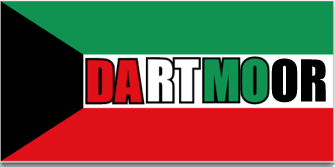
I promise this is the last of the ‘colourful’ pages and concerns the colour ‘green’ and the phrase,; “green and pleasant land” couldn’t be a more apt description of parts of Dartmoor. The actual word ‘green’ derives from the Anglo Saxon word grëne which translates as growing or living, Clark Hall, p.160. In landscape terms this would apply to any fertile ground that was known to grow excellent crops of one type or another. This would typically apply to hills, downs, combes, fens, or enclosures. Indeed when applied to tracts of land where livestock grazed it would signify areas of particularly lush grass that were popular locations amongst the moormen, the Green Hill at SX 636 678 being a prime example. Whilst describing the Jobber’s Path Hemery states that this was a trackway used by the moormen to drive their cattle onto Green Hill which in his words he describes as being; “the best pasturage in the southern quarter (of Dartmoor).”, p.269. In the case of Green Combe this similarly was renown for somewhere that was especially good for growing potatoes.
Having suggested that there are many ‘green’ and fertile spots on Dartmoor is it a coincidence that there are ten churches or religious buildings that contain Green Men symbols in them? Amongst other things the Green Man or Foilate Head represents fertility, renewal and rebirth. As Dartmoor has and is very much an agricultural area concerned with growing crops and rearing livestock maybe the proliferation of Green Men connect the two?
When it comes to lanes as in Green Lane or Greenaway there are two possibilities; today a green lane is regarded as an unsurfaced ancient route which is less frequently used and as a consequence has become overgrown with vegetation and therefore ‘green’. Whereas in the times when the routes were in frequent use the vegetation cover would have been from wayside trees and hedgerows and would have been less overgrown than today but still ‘green’.
When it comes to place-names that are water related the ‘green’ as opposed to any other colour may signify the presence of an abundance of water plants such as reeds or water weeds. It is unlikely on Dartmoor that any mineral would have the effect of giving the water a green appearance.
There is a possibility that some of the ‘green’ Dartmoor place-names are those that contain a personal element and over time the punctuation marks have been dropped, for example Greenawell could at one time of been ‘Green’s Well’ or the well belonging to Green?
In the case of Green Tor the name does not allude to the colour of the granite but simply to the fact that as Hemery notes; “There are two piles (outcrops), rounded and much grass-grown, giving the tor its name.”, p.978.
Below is a list of some of the Dartmoor place-names that have a ‘green’ descriptive element but there are numerous others when one takes into consideration the associated locations of the original place-name, ie. Green Tor and Green Tor water. Some of the information listed below have been taken from Mike Brown’s ‘Gazetteer of Dartmoor Place names’.
| GREEN BOTTOM | SX 637 751 | Bottom | |
| GREEN BRIDGE | SX 8200 8885 | Bridge | |
| GREEN COMBE | SX 696 835 | Combe | AKA Curlicombe, Potato’s once grown here. |
| GREEN DOWN | SX 714 696 | Down | |
| GREEN GERT | SX 554 832 | Gert | |
| GREEN HILL | SX 568 797 | Hill | |
| GREEN HILL | SX 636 678 | Hill | Best cattle gazing of S. Quarter. |
| GREEN LAKE | SX 635 652 | Lake | |
| GREEN LANE | SX 784 ? 771? | Lane | |
| GREEN LANES | SX 7550 7280 | Lane | |
| GREEN TOR | SX 5510 8798 | Tor | AKA Gren Tor and Grenny Tor. |
| GREENA BALL | SX 567 778 | Ball | AKA Yearlick Ball. |
| GREENACRES | SX 6973 8754 | Habitation | |
| GREENAWAY | SX 6645 8818 | Habitation | |
| GREENAWELL | SX 7298 8599 | Habitation | |
| GREENDOWN | SX 7071 6613 | Habitation | |
| GREENWELL | SX 6495 6556 | Habitation | |
| GREENWELL DOWN | SX 539 659 | Down | |
| GRENDON | SX 4952 7807 | Village | |
| GRENOFEN | SX 495 715 | Village |
So there you have it, the last of Dartmoor’s spectrum of ‘colourful’ place-names, there are a few yellows, blues, and goldens that occur but neither warrant a full webpage. Maybe a flag representing Dartmoor’s dominant place-name colours, ie black, white, red and blue could be borrowed from the Kuwaiti national flag, I’m sure they wouldn’t mind with all their wealth?


Clark Hall, J.R. 2004. A Concise Anglo-Saxon Dictionary. Canada: Cambridge University Press.
Hemery, E. 1983. High Dartmoor. London: Hale Publishing.
 Legendary Dartmoor The many aspects past and present of Dartmoor
Legendary Dartmoor The many aspects past and present of Dartmoor
